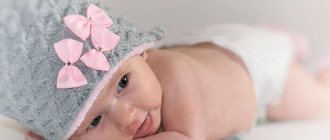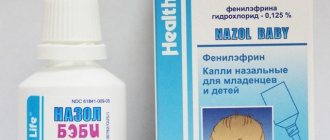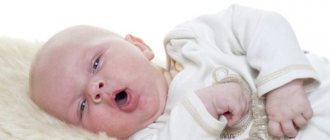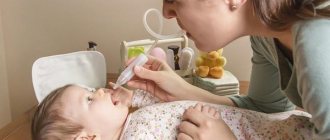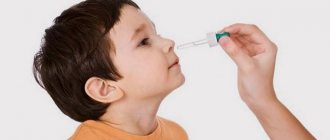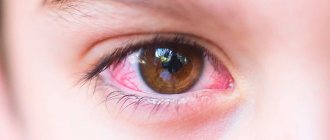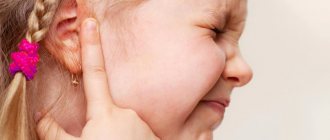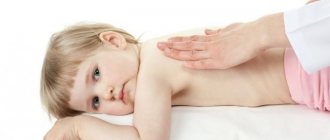Causes of rhinitis in children
Inflammation of the nasal mucosa occurs for a dozen different reasons, but the leading ones are:
- viral infection;
- bacterial infection;
- allergic reaction.
In addition, snot in a 3-year-old child can be the result of small parts of toys or construction toys getting into the nasal cavity. The foreign body gets stuck in the upper respiratory tract, which causes tissue swelling and increased mucus production in response to irritation.
Medicines are not effective in this situation; the child needs the help of an ENT specialist or surgeon.
Viral rhinitis
Most often, a runny nose in a 3-year-old child is initially caused by a viral infection. Influenza, parainfluenza, and adenovirus viruses enter the mucous membranes of the nasal cavity and upper respiratory tract, provoking the development of an inflammatory process.
Symptoms of viral rhinitis persist for 5-7 days, and if the child is not treated or treated incorrectly, the risk of a secondary bacterial infection increases.
This likelihood is higher if the baby suffers from adenoids or other chronic inflammatory processes in the nasopharynx.
Immunity is formed only at eight to ten years of age; children in the first years of life are practically defenseless against pathogenic microorganisms.
Bacterial form
Bacterial rhinitis develops in most cases as a complication of an untreated viral disease against the background of the addition of pathogenic microflora. Only in rare cases is this the primary process.
Bacteria multiply when the inflammatory process in the nasal cavity drags on for 10 days or longer, and also spreads to the sinuses and pharynx.
A bacterial runny nose in a 3-year-old child is more difficult to cure, which often leads to chronicity of the pathological process and complications in the form of sinusitis, adenoiditis, and sinusitis.
Runny nose with an allergic component
Allergic rhinitis develops against the background of exposure of the body to potential allergens and irritants.
They can be pet hair, indoor plants (their pollen), mold fungus, feather pillows, fabric softeners and washing powders, and air fresheners.
Allergic rhinitis in children very often develops due to constant irritation of the respiratory tract from tobacco smoke, which a child is forced to breathe in the house of smoking parents.
Additional symptoms of a runny nose
Integral symptoms of rhinitis in children are nasal congestion and discharge - these signs are sure to occur, regardless of the nature of the origin of the runny nose.
Additional symptoms of the disease may vary depending on the cause of the inflammatory process.
Viral rhinitis:
- swelling of the nasal tissues;
- abundant clear and watery snot in the first 2-3 days, which is then replaced by thick yellowish mucous;
- sneezing and itchy nose;
- impaired breathing;
- redness and burning of the skin around the vestibule of the nasal cavity;
- cough and sore throat.
Bacterial rhinitis:
- nasal congestion and disruption of full nasal breathing;
- thick yellow and green mucus discharge from the nose, sometimes mixed with pus;
- unpleasant odor from the nasal cavity when blowing your nose;
- impaired sense of smell.
Allergic rhinitis:
- nasal congestion;
- sneezing and itchy nose;
- redness of the skin around the nasal cavity;
- profuse watery discharge from the nose, accompanied in parallel by redness of the mucous membrane of the eyes and lacrimation in most cases.
Constant runny nose in children
The causes of persistent runny nose in children are varied. In the autumn-winter period, a runny nose, as an independent disease, as well as a symptom of another disease (for example, influenza and ARVI), occurs quite often. A runny nose in a child is a very unpleasant occurrence for his parents, especially for very young children who are not yet able to clean their nose on their own. Small children with a constant runny nose have difficulty eating and sleeping .
Remember that leaving a constant runny nose without treatment is not recommended, because it is very dangerous. Improper treatment of a child with a constant runny nose can cause chronic disease of the mucous membranes of the nose and paranasal sinuses.
Diagnostics
In order for the treatment of runny nose in children to be effective, it is important to correctly determine the cause of the development of the inflammatory process in the nasal cavity, since the treatment of viral, bacterial and allergic rhinitis is radically different.
First of all, do not try to treat your child yourself - this usually leads to unpleasant consequences.
The diagnosis and treatment of rhinitis in children 3 years of age should be carried out by an otolaryngologist together with a pediatrician or allergist (if there is a suspicion of an allergic origin of the runny nose).
When you first see a doctor, be prepared to answer the following questions:
- How long does a child suffer from nasal congestion and runny nose?
- Has your baby ever had a cold before?
- Does the child suffer from chronic nasopharyngeal diseases?
- Does anyone in the family smoke?
- Is the child registered with an allergist, and are there any cases of allergies in the family?
Such a detailed survey will allow the specialist to establish the preliminary cause of rhinitis in the child.
To clarify the diagnosis, instrumental and laboratory examination methods are prescribed:
- posterior rhinoscopy;
- X-ray of the sinuses (performed if sinusitis, sinusitis and congenital deviated septum are suspected);
- bacterial culture of nasal discharge on a nutrient medium - prescribed for suspected bacterial rhinitis, the study allows not only to accurately determine the causative agent of the inflammatory process, but also
- choose an effective medicine;
- blood test for allergy tests.
These studies are sufficient to make a diagnosis.
Yellow snot (discharge)
Yellowish snot (discharge) by itself does not mean anything. Any process begins with transparent, colorless compartments. If the matter drags on, then the snot (discharge) that continues for a month begins to thicken and acquire a characteristic yellowish tint. This is due to the fact that white blood cells, responsible for protection, destroy microorganisms that enter the nasal passages, which accumulate in the nasal secretion, giving it a characteristic yellow tint. You can’t start snot, otherwise it can result in consequences that are difficult to correct
This is a concrete reason to consult a doctor to clarify the cause of severe nasal discharge and to take timely measures.
Treatment of runny nose in children 3 years old
How to treat a runny nose in a 3-year-old child to prevent complications and harm? Treatment of childhood rhinitis is carried out comprehensively using medications and physical therapy. If the doctor sees the advisability of using folk remedies, it is possible to use alternative medicine recipes.
A prerequisite is the organization of a drinking regime: the child should drink more warm liquids.
This can be still water, fruit drinks, compotes. The liquid creates optimal conditions for the functioning of one’s own immunity, dilutes both snot and phlegm and helps remove toxins from the body.
Recovery always comes faster if you adhere to this rule.
General drug therapy
The main drug that is used for any type of runny nose in children 3 years old is a saline solution, it can be:
- hypotonic (0.65%) – used to rinse the nasal cavity and gently remove dried crusts and mucus;
- isotonic or physiological (0.9%) – actively moisturizes mucous membranes, promotes a speedy recovery of the child and supports local immunity;
- hypertonic - a sodium chloride solution with a concentration of 1-2% is used to rinse the nasal cavity and quickly eliminate swelling of the mucous membranes.
Saline solutions based on sterile sea water have proven themselves; they are available in the form of sprays and aerosols, are rich in mineral components and are easy to use.
For daily toileting of the child’s nasal cavity and active moisturizing of inflamed mucous membranes, the following drugs can be used:
- Dolphin;
- Aquamaris;
- Humer;
- Aqualor;
- Marimer;
- Physiometer;
- Otrivin Sea.
To ease breathing and relieve nasal congestion with rhinitis of various origins, vasoconstrictor nasal drops are used in pediatric dosages:
- Nazivin;
- Rinazoline;
- Farmazolin;
- Galazolin;
- Xylometazoline.
Important:
Before you start using nasal drops with a vasoconstrictor effect, carefully read the instructions - pay attention to the dosage and age restrictions, study the composition, as some drops contain additional components in the form of essential oils and herbal extracts.
Drugs in this group do not treat the cause of the runny nose, but only alleviate the symptoms of the disease. Remember that vasoconstrictor nasal drops can be used in children for no longer than 5 days in a row, as the likelihood of the body getting used to it and developing a medicated form of rhinitis increases sharply.
Read more about this group of drugs and the features of their use here.
Features of bacterial therapy
To treat bacterial rhinitis, in addition to the drugs described above, agents with antibacterial properties are prescribed, for example, Collargol or Protargol drops.
These drugs contain colloidal silver, a powerful natural antiseptic that has a detrimental effect on gram-positive and gram-negative microflora, fungi and some viruses.
In the event that the inflammatory process in the nose involves all sinuses and cavities, the child is additionally prescribed plant-based drops Sinupret for oral administration.
In especially severe cases, when the infection has spread to the throat, a course of antibiotic therapy is recommended. Specific names of drugs are selected by a pediatrician after determining the sensitivity of pathogens to a particular bacterial agent.
It is strictly forbidden to instill antibiotic solutions or homemade antibiotic drops into a child’s nose - this can cause a serious allergic reaction (Quincke’s edema and anaphylactic shock).
Eliminating the allergic component
If rhinitis of allergic origin is detected, the main drug will be a spray or aerosol based on hormones:
- Avamis;
- Allergodil (at 3 years of age, prescribed by a doctor carefully, in case of emergency. According to the instructions, the medicine is intended for children over 6 years old).
The huge advantage of these drugs is that the medicine acts only locally, that is, it is practically not absorbed into the general bloodstream, thereby minimizing the risk of side effects and overdose.
However, all drugs in this group are prescribed only by a pediatrician and are not intended for independent use.
About a constant runny nose
The cause of a constant runny nose may be an allergy.
Often, a constant runny nose in children becomes not just an annoying problem that worries the baby and worries the parents. This disease is especially widespread in the autumn and winter periods. It is important to remember that a constant runny nose can appear as an independent disease, also as a consequence after hypothermia and adaptation to new climatic conditions. A constant runny nose can be a symptom of a respiratory disease, therefore, it is very important for parents to promptly pay attention to the well-being of their child and not allow the child’s disease to become chronic.
A constant runny nose and nasal congestion seem to us to be a common condition that we encounter more than once a year. But it is a constant runny nose that brings us a lot of inconvenience: headaches, the use of constant handkerchiefs, a red nose and obscene looks from people around us - this is only a small part of the entire list.
Physiotherapeutic treatment
Physiotherapeutic methods for treating runny nose in children 3 years old include:
- Inhalations - carried out through a nebulizer or thermal, using medications (for the first) and herbal decoctions or essential oils for thermal inhalers or adding them to a basin of hot water. Inhalations for a runny nose can only be carried out at normal body temperature, after first clearing the nasal cavity of mucus and crusts with a saline solution. During the procedure, you need to breathe calmly through your nose, do not talk, do not spin, so as not to injure yourself (when inhaling over hot steam) and not to damage the device (when using a nebulizer).
- UVR – an ultraviolet ray is directed into the child’s nose, which helps eliminate tissue swelling, reduces the amount of discharge, and stimulates the process of regeneration (rapid healing) of microscopic cracks in the nasal mucosa.
- Laser therapy is a method effective for acute and chronic forms of treatment. After the procedure, tissue swelling is significantly reduced, nasal breathing is facilitated, and signs of the inflammatory process are reduced.
A 1.5 year old baby has a runny nose: how to relieve the condition
After prescribing treatment, you must carefully follow the doctor’s advice and recommendations in order to cure a runny nose in a 1.5-year-old child. But, still seeing how the baby suffers from excess mucus, I want to help him. How to do this without causing harm?
- Cleaning the nasal cavity will in any case improve the baby’s well-being. You can remove excess mucus using a nozzle ejector or aspirator, as well as a simple syringe without a needle. Then you need to drop a drop of saline solution into your nose to prevent a crust from forming. Do not rinse your baby's nose at such a young age. Washing will lead to otitis media and other side effects.
- Treatment of a runny nose in a 1.5 year old child requires attention and patience. Position your baby so that his head is higher than his body. Then mucus will not constantly accumulate in the nasal cavity in huge quantities.
- During the treatment of a runny nose in children 1 year old or 18 months old, it is important to ensure that the humidity in the room is regularly maintained. It is necessary to ventilate the room and wash the floor with a wet cloth as often as possible. This does not allow the mucous membrane to dry out - when the baby breathes, he will inhale moist air.
Alternative medicine
Non-traditional methods of treating childhood rhinitis include many procedures, but they should not be used as the main method of therapy.
Folk remedies cannot compete with medications in terms of effectiveness and are used only as auxiliary measures to enhance the pharmacological effect of traditional drugs.
The most common are:
- Mustard “socks”.
Dry mustard is poured into the child’s socks and left for 6-8 hours. It is believed that the procedure helps to expand the blood vessels of the feet and stimulates the outflow of fluid from the upper half of the body, accordingly the child should improve nasal breathing and reduce nasal congestion.
The effectiveness of this method has not been scientifically proven, but many parents claim that mustard “socks” are very effective and help cure colds faster.
- Foot baths.
Since the time of our grandmothers, it has been customary to hover our feet at the slightest sign of a cold, in order to prevent the disease from progressing.
The procedure can only be performed if the child does not have a fever or fever. The water for the procedure has a temperature of 39-40 degrees; 1-2 drops of eucalyptus or fir oil can be added to the basin if the child does not have allergies or individual intolerances.
- Warming the nose with a bag of warm salt or a boiled egg.
Despite the fact that many people actually resort to a similar procedure for treating a runny nose, it is better not to use such methods in pediatric practice.
Heating the nasal cavity during an acute inflammatory process will cause even greater swelling of the tissues; accordingly, congestion will not disappear, but will only intensify.
If a child’s runny nose is of a bacterial nature, then the procedure is dangerous and can lead to the spread of infection to the maxillary sinuses, meninges, larynx, trachea, and bronchi.
Homemade nasal drops based on the juice of the Kalanchoe leaf are also widely known, but it is better not to use such methods for treating children, since the side effects are often greater than the benefits.
Runny nose in young children
Treatment of a runny nose in a 1.5 year old child with medications
It is important at this age not to harm the baby with the treatment. Here, a lot depends on what other symptoms accompany rhinitis. If the body temperature is not elevated, then a runny nose in a 1-year-old child can be cured using symptomatic medications.
It is not recommended to arbitrarily choose medications without consulting a doctor. Parents may not pay attention to the details or simply not know some of the features of the medicine and cause harm to the baby’s health instead of the expected recovery.
When prescribing medications that can cure a runny nose in a 1.5 year old child, the pediatrician chooses between the following types of drops:
- drops that constrict blood vessels,
- drops that soften dry crusts in the nose,
- antiviral drops,
- antiseptic drops.
Drops NazolBaby
Most often, NazolBaby drops are prescribed to treat a runny nose in a 1-year-old child. In addition to these drops, there are also such as:
- "Nazivin"
- "Derinat"
- Oil drops with vitamins A and E.
Remember that Nazol Baby nasal drops can be used to treat a runny nose at 1.5 years old, and Nazol baby spray can be used exclusively for children over 6 years old.
The drug Nazol Baby is popular for the simple reason that the drops can be used by children from birth, and this is something that always scares parents. Many people fear that early use of medications may lead to addiction or other complications. There are no such consequences from Nazol drops. The average price for nasal drops Nazol Baby is 175 rubles. And this low price is another reason for the popularity of the medicine.
